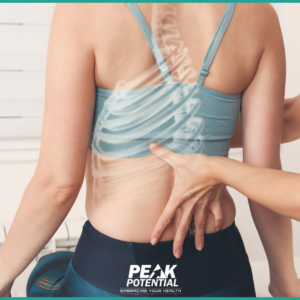
Do you feel like you still look pregnant months after giving birth? Does you stomach bulge when you try to do an ab exercise? Do you feel especially weak through your core and low back after having a baby?
If so, you might have diastasis recti.
Diastasis recti is a term used to describe the separation between the stomach muscles. If I had six pack abs, this would be the line down the center called the linea alba. During pregnancy, this line widens in order for the belly to expand and make room for a growing baby. In fact, it is believed that 100% of women have some level of diastasis of the rectus abdominus muscles in the third trimester. This “thinning” down the middle is different than a hernia where tissue actually tears – and that is much less common.
Unfortunately, this “gap” doesn’t always miraculously come back together after childbirth. Studies show, if this separation remains at 8 weeks postpartum, and left untreated, the distance usually remains one year later. This is the case for about 1/3 of postpartum moms. And this results in what some women call their post baby “pooch”.
Although the look of the stomach is often women’s initial concern, it isn’t just about aesthetics. This abdominal separation can cause low back and pelvic pain, constipation, organ prolapse, urinary leaking, and a general feeling of weakness. The abdominal muscles – and entire core system – have an impaired ability to do their best work, which can make every day tasks of life harder by inhibiting breathing and normal movement.
This might all sound like bad news, but it’s really quite phenomenal. As a woman, your body is doing an amazing thing by accommodating for a growing baby. The good news is that once the baby is out in the world and no longer taking up residence in your belly you midsection CAN HEAL!
For most women, this healing occurs naturally, but for some it requires some extra effort. In very rare cases is surgical intervention required to actually bring the two muscle bellies back together. It’s also important to note that completely “closing the gap” between the two muscles isn’t always necessary to regain functional strength and movement patterns.
Although there isn’t one exact protocol that will heal every case of diastasis recti because every woman’s body is different, there are things I have found that consistently help the women I work with improve their diastasis recti:
-
Stay Aligned
Keeping your body aligned – otherwise known as having good posture – allows you core to work optimally. Postures where you feel strong and supported are especially important when you are carrying a baby or lifting something such as a car seat.
-
Avoid Straining
Any reason for straining should be avoided because this increases intra-abdominal pressure further stretches the linea alba. Straining activities may include lifting something heavier than your body is used to or even excessive pushing to have a bowel movement.
-
Connect the Core and Pelvic Floor
The diaphragm, core muscles, and pelvic floor work in synergy with every move we make and every breath we take. Take some time to take a few deep breathes and see how your core muscles and pelvic floor respond. This might sound simple, but it is foundational to core strength and coordination.
-
Create Strength and Tension
Perform strengthening exercises that do not cause a bulge in your abdomen. This will allow you to build strength without causing further damage to the abdominal wall and pelvic floor muscles. Go back to the very basics of locating, contracting, and relaxing the transverse abdominal muscle. If you don’t know how to do this, find an expert to help you get started.
-
Avoid Belly Bulging Exercises
Any activity that causes bulging of your stomach can make a diastasis worse. Until you have regained the strength and function of your stomach, you want to avoid sit-ups, crunches, curl ups, V-ups, and even planks if you see your abs bulge.
-
Nourish Your Body
The bodies healing ability is fueled by the foods we consume. Consuming a wide variety of fruits and vegetables will provide your body the vitamins and minerals it needs to rebuild strong connective tissue.
-
Start wherever you are
Activating and engaging your core muscles and learning to re-align your core and pelvis can be done at any stage postpartum. Depending on the degree of separation and the amount of times that’s passed, you may not bring the muscles back together completely, However, you can definitely make improvements to strength, stability AND the way your tummy looks!
A good healing program must ensure that you are taking care of the root causes – why the diastasis occurred in the first place and what is keeping it from healing naturally. Common root causes are pelvic or postural alignment issues, impaired breathing patterns, muscle imbalances, and too much intra-abdominal pressure. Targeting those issues thoroughly is essential to healing.
Physical therapists don’t have one standard guideline on what exercises will bring the belly muscles back into line and one protocol will not work for everyone. In addition, since the core interacts with every other part of the body, healing must include work in other areas of the body as well. The whole body needs to find balance, alignment, and optimal function.
Your best option is to work with a specialist physical therapist – even if you have found exercises online that you think might help. The truth is that no two women’s health issues are exactly the same and the strategy your friend used may cause more harm than good for you. Proper healing postpartum is far too important too rely on a one size fits all approach. Your future self will thank you!
Would you like some extra help in figuring out your next best step? (or even still not sure if you have diastsis recti?) Then feel free to book a call with me.
You can reach me by dialing 901-316-5456 and we can discuss some options that can help you achieve results as fast as possible. Ready to get some help with this ASAP . . . then you can click the link below to set up an appointment.




